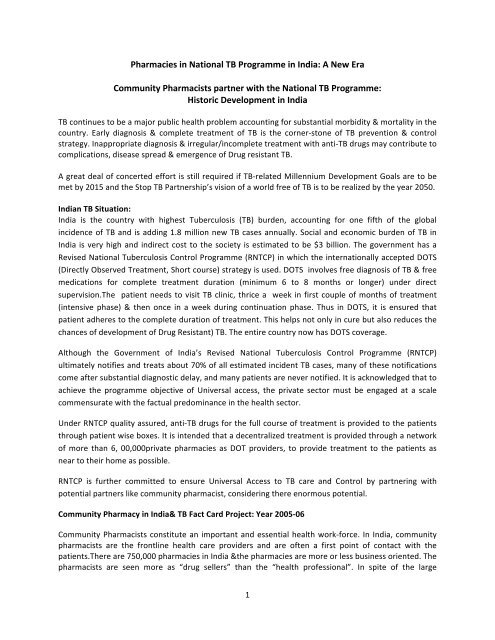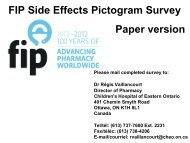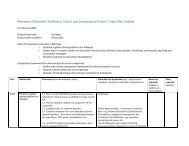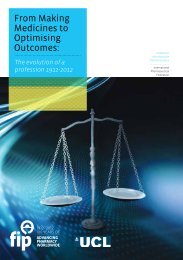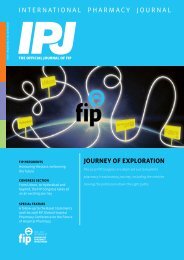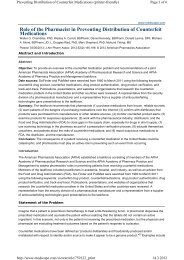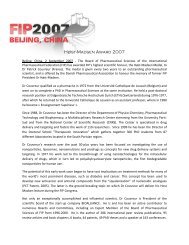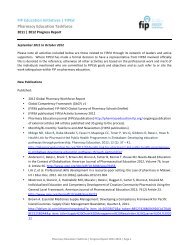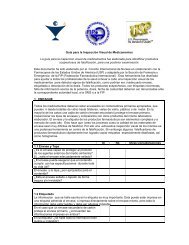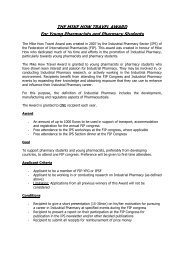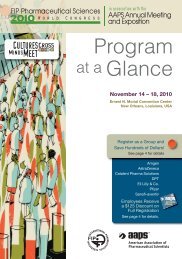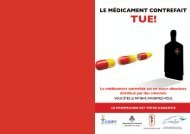here - FIP
here - FIP
here - FIP
Create successful ePaper yourself
Turn your PDF publications into a flip-book with our unique Google optimized e-Paper software.
Pharmacies in National TB Programme in India: A New Era<br />
Community Pharmacists partner with the National TB Programme:<br />
Historic Development in India<br />
TB continues to be a major public health problem accounting for substantial morbidity & mortality in the<br />
country. Early diagnosis & complete treatment of TB is the corner-‐stone of TB prevention & control<br />
strategy. Inappropriate diagnosis & irregular/incomplete treatment with anti-‐TB drugs may contribute to<br />
complications, disease spread & emergence of Drug resistant TB.<br />
A great deal of concerted effort is still required if TB-‐related Millennium Development Goals are to be<br />
met by 2015 and the Stop TB Partnership’s vision of a world free of TB is to be realized by the year 2050.<br />
Indian TB Situation:<br />
India is the country with highest Tuberculosis (TB) burden, accounting for one fifth of the global<br />
incidence of TB and is adding 1.8 million new TB cases annually. Social and economic burden of TB in<br />
India is very high and indirect cost to the society is estimated to be $3 billion. The government has a<br />
Revised National Tuberculosis Control Programme (RNTCP) in which the internationally accepted DOTS<br />
(Directly Observed Treatment, Short course) strategy is used. DOTS involves free diagnosis of TB & free<br />
medications for complete treatment duration (minimum 6 to 8 months or longer) under direct<br />
supervision.The patient needs to visit TB clinic, thrice a week in first couple of months of treatment<br />
(intensive phase) & then once in a week during continuation phase. Thus in DOTS, it is ensured that<br />
patient ad<strong>here</strong>s to the complete duration of treatment. This helps not only in cure but also reduces the<br />
chances of development of Drug Resistant) TB. The entire country now has DOTS coverage.<br />
Although the Government of India’s Revised National Tuberculosis Control Programme (RNTCP)<br />
ultimately notifies and treats about 70% of all estimated incident TB cases, many of these notifications<br />
come after substantial diagnostic delay, and many patients are never notified. It is acknowledged that to<br />
achieve the programme objective of Universal access, the private sector must be engaged at a scale<br />
commensurate with the factual predominance in the health sector.<br />
Under RNTCP quality assured, anti-‐TB drugs for the full course of treatment is provided to the patients<br />
through patient wise boxes. It is intended that a decentralized treatment is provided through a network<br />
of more than 6, 00,000private pharmacies as DOT providers, to provide treatment to the patients as<br />
near to their home as possible.<br />
RNTCP is further committed to ensure Universal Access to TB care and Control by partnering with<br />
potential partners like community pharmacist, considering t<strong>here</strong> enormous potential.<br />
Community Pharmacy in India& TB Fact Card Project: Year 2005-‐06<br />
Community Pharmacists constitute an important and essential health work-‐force. In India, community<br />
pharmacists are the frontline health care providers and are often a first point of contact with the<br />
patients.T<strong>here</strong> are 750,000 pharmacies in India &the pharmacies are more or less business oriented. The<br />
pharmacists are seen more as “drug sellers” than the “health professional”. In spite of the large<br />
1
presence, Indian Community pharmacists have not been involved in any National Health Programs<br />
including National TB Programme. They have been described as missing link in TB controlIndian<br />
Pharmaceutical Association initiated Systematic efforts to involve pharmacists in TB care and control<br />
since year 2005 with TB Fact Card Project in Mumbai. It was oneof the first efforts to involve<br />
pharmacists in fight against TB with support from Commonwealth Pharmacists Association (CPA) &<br />
International Pharmaceutical Students’ Federation (IPSF) .The project focused on creating awareness<br />
about TB & monitoring of TB patients’ treatment to improve ad<strong>here</strong>nce. Many of the participant<br />
pharmacists took interest& performed well.This gave some confidence to the project leaders that yes;<br />
the pharmacist-‐centric model can be developed for TB control.<br />
This project gave opportunity to the organizers to look deeply into the TB related issues. From the<br />
RNTCP reports, it was clear that.<br />
• The highest priority should be to further improve the quality and reach of DOTS services in the<br />
country and<br />
• The proportion of TB patients being treated outside the DOTS strategy needs to be minimized<br />
to reduce incidence of resistant TB .<br />
To achieve this, RNTCP has several public-‐private partnerships to expand the provision of DOTS.But the<br />
pharmacist’s potential had remained untapped in this regard. It was realized that Pharmacies are in the<br />
suitable position to initiate DOT & make it widely available to the public. Pharmacies being so<br />
conveniently located in the community, open for long hours, pharmacist’s medicine expertise & friendly<br />
relation with the customers make it perfect set up for DOT. The pharmacists, when trained, can create<br />
awareness aboutTB, help in early case detection/referral & can act as DOTS provider.<br />
DOTS TB Pharmacist Project: Year 2006 onwards<br />
Understanding of the urgent needs of RNTCP & the positive experience of Fact Card project was<br />
stimulating enough to work for this new venture. Different segments had to be mobilized & brought<br />
together for initiating this work. The first & foremost was to tap the minds of the pharmaciststhrough<br />
their associations. Discussion with pharmacists revealed that some, if not all, are willing to take up such<br />
activity. Then Chemist associations were approached & they showed readiness.<br />
The Government TB authorities were approached & the concept was explained .They welcomed the idea<br />
but again had some apprehensions about this model. After the follow up discussions, their support was<br />
ensured.<br />
Next, Food & Drug Administration (FDA) was approached to get approvals for stocking Government’s<br />
free medicines in the private pharmacies.Several rounds of discussions were held with the<br />
authorities.Finally permission to go ahead was given based on certainterms&conditions.After this<br />
groundwork, a RNTCP training was organized for willing pharmacists in Mumbai region & this half day<br />
training focused on case detection&DOTS protocols .It all started with training 10 pharmacists in 2006 &<br />
later 40 more pharmacists were trained in Year 2007-‐08. State TB authorities released authorization<br />
letter for trained participants & information was given to FDA.<br />
2
Majority of the trained pharmacists started referring cases & were able to detect sputum positive TB<br />
cases. Pharmacists also started distributing TB information leaflets, which were placed in specially<br />
designed boxes in the pharmacies indicating TB symptoms & free treatment DOTS.Several of the<br />
pharmacists soon had TB patients on treatment with DOTS medicines & were monitoring the treatment.<br />
Patients felt quite comfortable&convenienttoget treated at pharmacies. RNTCP field staff werein touch<br />
with these DOT Provider pharmacists & patients. This collaborative mechanism was working well for the<br />
patients. First time in the history such public-‐private partnership was getting established in organized<br />
manner with Indian pharmacies. The pharmacists were working with no financial incentives but their<br />
work was fetching them good recognition socially & professionally. Reports in the media also recognized<br />
the potential role they could play. In 2010,the project was scaled up by IPA with <strong>FIP</strong>, SEARPharm Forum<br />
and sponsorship from Lilly MDR TB Partnership.<br />
At present,more than 330 pharmacists have been trained & are working for this social cause in Mumbai<br />
region & other parts of the state of Maharashtra. A special training tool kit has been developed by IPA<br />
along with a short documentary on pharmacists work.These tools are used during the training. IPA is<br />
now working with 8 City TB Corporations & this public-‐private partnership is established well. This is a<br />
good example of a sustainable model. Pharmacists are included by each Corporation in the DOTS<br />
directory of the Program. Now the trained pharmacists are known DOT providers in each of the<br />
Corporation & their efforts are facilitated by the other health workers even without project organizer’s<br />
intervention.<br />
Advocacy for National Scale Up:<br />
One of the direct outcome of the intervention at the Project sites was the increase in case detection &<br />
increased outreach of DOTS services for the community. Encouraged with the success of this<br />
pharmacist model in Mumbai region & realizing the huge potential of pharmacists’ contribution in TB<br />
care & control, it was felt that this model needs to be scaled up in the entire country. To achieve<br />
this,what was most needed was support of RNTCP. Strong advocacy initiatives were taken by IPA &<br />
SEARPharm Forum. The <strong>FIP</strong>-‐WHO Joint Statement on role of pharmacist in TB Care & Control, signed in<br />
September,2011 at <strong>FIP</strong> Congress, in Hyderabad helped to strengthen these advocacy initiatives.<br />
IPA organized a two days workshop “Pharmacies in RNTCP” with help of Central TB Division,Ministry of<br />
Health in Feb,2012. The evidence of pharmacists’ contribution was shared with the policy makers, the<br />
NationalTB Programme (NTP) managers. Documentary showing the experiences of pharmacists,<br />
patients, RNTCP Staff, supported with the data from the project sites was shown. Few DOT provider<br />
pharmacists, City TB Officers, WHO RNTCP Consultants, Chemist associations shared their experiences of<br />
last 2 years .IPA also presented the Road Map for the national scale up.Other NGOs such as PATH &<br />
REACH also shared their positive experiences of working with pharmacists.Overall,it became very clear<br />
that pharmacies in RNTCP will be very useful for improving universal access to TB care for the TB<br />
patients. The NTP managers announced that the pharmacists’ potential has remained untapped & t<strong>here</strong><br />
is need for policy to include pharmacies in TB programme in entire country. IPA followed up<br />
consistently with the policy makers.<br />
3
On April, 27th 2012, Central TB Division proposed and signed an MoU with IPA & All India Organization<br />
of Chemists & Druggists, SEARPharm Forum & Pharmacy Council of India for inclusion of pharmacies in<br />
RNTCP pan India. This is the historic development & milestone for pharmacy profession of India as it<br />
very first time the pharmacies are included in any such national health programme. It isrecognitionof<br />
the pharmacist as health care professional. The Central TB Division aptly announced that this MoU is for<br />
the human care & is a beginning of partnership between the Government & the pharmacists. Initially<br />
the model will be implemented in 3 states & then will be implemented in the entire country in phased<br />
manner. National Core Committee is being formed to periodically review the pharmacists’ participation<br />
in RNTCP. The MoU clearly describes the role of each partner & the processes for<br />
implementation.International Organizations would be visiting Mumbai to study pharmacist’s role & this<br />
model for TB care.The model will be evaluated for its replication in high TB burden countries.<br />
Signing of the MoU<br />
Capacity building and skill enhancement and continuous engagement, helped in reorienting the role of<br />
community pharmacist from drug vendors to a skillful human health resource. Moreover, focused<br />
persistent advocacy efforts influenced the national policy change. IPA's work served as “Agent of<br />
CHANGE” benefiting the TB patients as well as enhancing the image of the pharmacists.<br />
Authors : Manjiri Gharat, Praful D Sheth, Shibu Vijayan, Sunita Prasad<br />
Author information<br />
Manjiri Gharat : Vice-‐President & Chairperson of Community Pharmacy Division, Indian Pharmaceutical<br />
Association. Leads the initiative & development of the pharmacist model in Mumbai & is now working<br />
closely with Central TB Division, Ministry of Health, Govt of India & with Chemist Associations for the<br />
national scale up.<br />
P. D. Sheth-‐<strong>FIP</strong> Vice President and Secretary, SEARPharm Forum,based in Delhi<br />
Dr Shibu Vijayan, is a Medical Doctor and a Public Health Specialist who supports Ministry of Health ,<br />
Government of India, National Tuberculosis Control Program, in building Public Private partnership<br />
policy, based in Delhi<br />
Sunita Prasad-‐ Consultant MDR-‐TB and CSR at Eli Lilly and Company (India) Pvt. Ltd,based in Delhi<br />
4


